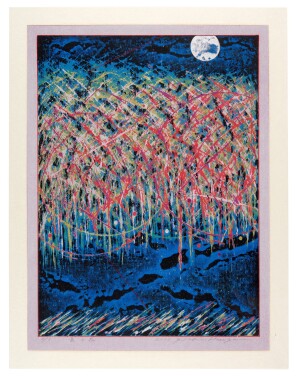S otheby’s Japanese Woodblock Prints Including the Sokolov Collection features an extensive selection of prints from the dawn of colour woodblock printing in the late 18th century to printmakers of the modern day. Graceful bijn-ga [prints of beauties] such as Torii Kiyonaga’s idyllic Intoxicating Flowers of Asukayama and Kitagawa Utamaro’s elegant Firefly Cage in the Evening are followed by fine examples from Katsushika Hokusai and his age, with prints from the renowned Thirty-six Views of Mount Fuji and poetic surimono by Totoya Hokkei.
A selection of striking prints from the Meiji period include Tsukioka Yoshitoshi’s designs from the series One Hundred Aspects of the Moon, and prints by Kawanabe Kyosai, such as the jocular triptych Comic One Hundred Turns of the Rosary.
The sale culminates in a wide range of works from the Shin-hanga and Sosaku-hanga movements – counting impressions from Ito Shinsui’s beauties and Kawae Hasui’s landscapes, to the bold compositions of Kiyoshi Saito and Azechi Umetaro.
Auction Highlights

Dr. Sam Sokolov’s interest in Japanese art began around 1945 at the end of World War II, where he served in the US Army during the allied forces occupation of Japan. While awaiting discharge from the Army, he came across many kinds of Japanese art including woodblock prints, which made their aesthetic mark on him and sparked a lifelong passion.
Many years later, in the 1960s, after he had settled in New York, married Selma, became the father of three sons, and opened a practice as a podiatrist, he noticed an ad in a local newspaper for the sale of Japanese woodblock prints. He went to look and was fascinated by this incredible artwork. It was then that he bought his first prints. There began his interest in and acquisition of a large collection of prints and a library of Japanese and Asian art literature.
Dr. Sokolov then began to further educate himself and study everything about the artists, the creative process and the history of Ukiyo-e. He became a member of the Japanese Art / Ukiyo-e Society of New York, attending their meetings and exhibits regularly, and he cultivated friendships with several other Ukiyo-e collectors and dealers. He wrote articles on ukiyo-e for various journals, and several times presented talks and slideshows about his collection to groups of interested people.

Sam Sokolov was born in 1922 in Brooklyn, New York, to immigrant parents. He was a completely self-invented man who in addition to collecting prints, was a painter and artist himself, as well as a wood craftsman who designed and built unique and beautiful wood furniture.
Dr. Sam Sokolov’s passion for Japanese prints and his ability to find and acquire works of great artistic value and beauty continued throughout the rest of his life until his death in December 2020 at age 98.
The Sam Sokolov collection of Japanese ukiyo-e is extensive and contains wonderful works of art. Dr. Sokolov had a decades-long passion for developing and expanding this unique and diverse collection. He would have hoped others would gain as much knowledge and pleasure from his collection as he did.
Featured Lots

Featured Lots

Featured Lots

The spring season is iconically celebrated in Japan when the profusion of cherry blossoms trees flower around the months of April and May. Viewing cherry blossoms, known as hanami [lit. viewing flowers] in Japanese, has been a favourite pastime for centuries, evident in the designs of ukiyo-e in the Edo period.
An elegant group can be seen pausing beneath the bower of a cherry blossom tree in Torii Kiyonaga’s Intoxicating Flowers of Asukayama, Hiroshige’s Cherry-blossom Viewing on the Hill of the Tenjin Shrine in Yasui sees a group of revellers enjoying food, sake, music and dance surrounded by the blossoms.
Later woodblock prints in 20th century also feature cherry blossoms as their subject, often portraying the flowers in bolder, heightened colours. Throughout Japanese art and culture, artists and poets alike have sought to capture this momentary beauty of spring.
Featured Lots
In the early 20th century, modern Japanese prints generally evolved into two groups: Shin-hanga [lit. new prints] and Sosaku-hanga, or creative prints. Shin-hanga stayed along the more traditional path and followed the make-up which constituted the printing process of woodblock printing in the Edo and Meiji periods preceding.
Artists still worked closely with their publishers, and designated carvers and printers completed the woodblocks from the artist’s sketches. Ito Shinsui, Kawase Hasui, Yamakawa Shuho and other artists, most often published by Watanabe Shozaburo, fall into this category, with the publisher Watanabe Shozaboru at the new movements helm.
Sosaku hanga more distinctly looked to the West to inspire their medium. With a new sensibility of individualism, these artist’s extolled personal expression and originality, often taking on the entire production process of their work. Works by Kiyoshi Saito, Masao Maeda and Sekino Jun’ichiro reflect this push for an idiosyncratic expression.

















































